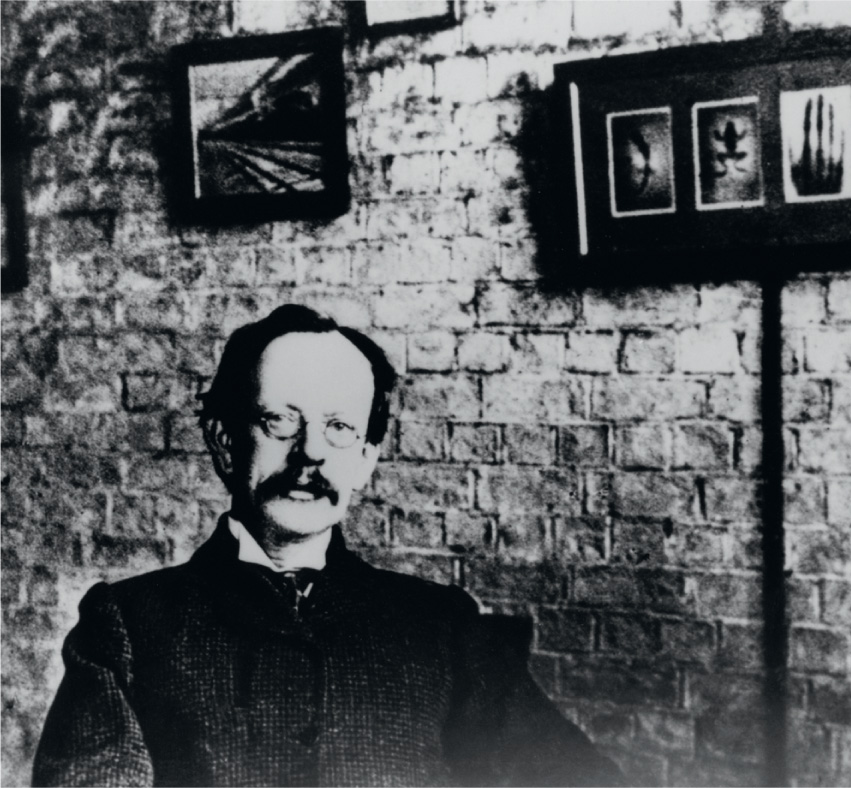
J. J. Thomson (1856–1940).
The electron was a discovery waiting to happen, and several experimenters converged on the discovery in the 1890s. The key contributor was the British physicist J. J. Thomson (always referred to by his initials, never his full name), working at the Cavendish Laboratory in Cambridge.
In 1894, Thomson found the first clue when he measured the speed of cathode rays passing through a Crookes Tube (see here) and found that it is much less than the speed of light. So cathode rays could not be a form of electromagnetic radiation, because Maxwell’s equations tell us that all such radiation travels at the same speed. A year later, the Frenchman Jean Perrin discovered that a beam of cathode rays could be bent sideways by a magnetic field, implying that the beam is made up of a stream of electrically charged particles; the direction of the deflection showed that the particles must carry a negative electric charge.
But what were the particles? Walter Kaufmann, working in Berlin, thought that they must be electrically charged atoms (now known as ions). He thought that cathode rays were atoms that had picked up negative electric charge from the cathode, and he measured the way cathode rays were deflected by electric and magnetic fields in vacuum tubes containing traces of different kinds of gas. He was able to work out the ratio of the charge of the particles to their mass (usually written as e/m), and expected to get different values for the different gases, because they had different atomic weights,. But he always got the same value for e/m.


Thomson also measured e/m for cathode rays, but unlike Kaufmann he expected to get the same value all the time, because from the start he thought that cathode rays were streams of identical particles being emitted from the cathode. So he used tubes with as pure a vacuum as possible (the best vacuum tubes in the world at the time) to avoid contamination, and devised a clever technique in which the beam was simultaneously being pushed one way by a magnetic field and the opposite way by an electric field. By adjusting the strengths of these fields, he could end up with a beam travelling in a straight line, and the strengths of the fields needed to achieve this enabled him to work out e/m.
Although at this stage Thomson had a value only for the ratio, not for the charge and mass separately, he could compare this with the value he got for similar experiments he carried out with electrically charged atoms (ions) of the lightest element, hydrogen. This told him that either the mass of the particles of cathode rays was very small, or the charge was very large, or some combination of these effects. This raised the possibility that the particles involved, which he called corpuscles, were smaller than atoms, and might be parts of atoms that had escaped or been knocked off. In a lecture to the Royal Institution on 30 April 1897, Thomson said, ‘the assumption of a state of matter more finely divided than the atom is a somewhat startling one’. He later recalled that at least one member of the audience thought that he had been pulling their leg; the idea of the atom not being indestructible was that outrageous in the 1890s.
Thomson’s ‘corpuscles’ were soon dubbed ‘electrons’, and with the benefit of hindsight 1897 is now usually regarded as the year of the ‘discovery’ of the electron. But it was another two years before Thomson was able to measure the electric charge itself, in experiments involving ultraviolet light falling on metals and triggering the emission of negatively charged particles – the photoelectric effect. He measured e/m for these particles and showed they were identical to his cathode ray corpuscles, then measured their charge by monitoring water droplets charged by these particles moving in electric fields. Combining these measurements with the measurements of e/m made it possible to work out the mass of the individual corpuscles/electrons, which turned out to be just one two-thousandth of the mass of a single hydrogen atom. In the Philosophical Magazine, Thomson wrote in December 1899: ‘On this view, electrification essentially involves the splitting up of the atom, a part of the mass of the atom getting free and becoming detached from the original atom.’28 The atom, it was clear, is not indivisible, and this marked the real moment of the discovery of the electron.